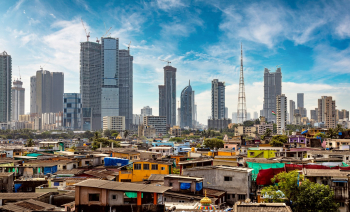Article originally published in the public group Fighting Inequalities through development cooperation and stronger partnerships
The EU has a strong commitment to reducing inequality. This has been outlined in numerous policies, texts and agreements, such as the EU Charter of Fundamental Rights, the Treaty of Lisbon and the European consensus on development.
Inequality refers to the unequal distribution of goods, resources and rights and it is inherently a relational concept. Unlike poverty, which focuses on the segment of the population for which living standards fall below a minimum level (i.e. the poverty line), inequality refers to differences in social and economic outcomes and opportunities across the whole population, as well as between and within groups.1
DG INTPA has kept pace with the global reflection on inequalities and has moved beyond the objective of poverty reduction to that of inclusive, equitable and sustainable growth. Earlier this year, INTPA G.4 organised the webinar Mainstreaming Inequalities in Programming and Operations. Its goal was to build the capacity of EU staff by linking multiple policy areas to inequalities. The webinar built on the experience of the Research Facility on Inequalities and the reference document Addressing Income Inequalities through Development Cooperation in DG INTPA Tools and Methods Series.
So, what principles and recommendations are available for the design and implementation of development cooperation programmes contributing to the reduction of inequalities?
|
Guiding principles: |
For any policy or programme aiming to reduce inequalities, particular attention must be paid to focusing its design on targeting the beneficiaries, namely the poorest and the marginalised, as well as to the efficacy of the targeting itself. Such policies should not only target the most vulnerable but also include them in the process, throughout the programming and project cycle. Some measures are recommended below:
- Use participatory approaches to consult and involve key national or local stakeholders in the design of effective responses targeting the most vulnerable.
- Support the participation of women and marginalised groups to learn how to better address the structural causes behind discrimination against them, and how different policies and cultural norms and attitudes affect them.
- Support and promote the participation of diverse stakeholders, especially people from marginalised and excluded communities, in context analysis, programming, formulation and identification, implementation, and monitoring and evaluation.
- Support and facilitate the reinforcement and capacity building of existing social dialogue mechanisms, including different actors from different constituencies and at different levels.
A lack of accountability and transparency is a breeding ground for corruption, which strongly favours inequality.2 Insufficient (or no) access to information (e.g. on policy decision-making processes and agreements, budget allocations, etc.) reduces opportunities for people to influence and improve their lives. Similarly, a lack of the disaggregated data required to measure and expose inequalities makes the situation invisible, thus implying that governments make decisions without consideration for their impact on inequalities.
The need to increase transparency goes hand in hand with the need to create, facilitate and protect spaces for civil society participation, so that the voices of the most marginalised are heard.
Some action in this direction includes the following:
- Steer cooperation towards strengthening democratic institutions, in particular in relation to freedom of information legislation and public and private accountability, including through digital governance.
- Promote transparency and access to information, including information regarding decision-making, contracting processes, land reform, and tax and budgeting initiatives.
- Support national statistical systems and their capacity to generate disaggregated data related to inequalities between different groups of people.
- Support anti-corruption laws and measures, as well as their implementation and the institutions in charge of them.
- Support building the capacity of civil society organisations, their access to information, their ability to conduct research and analysis in key areas, and their involvement in the implementation of social audit initiatives (e.g. public hearings).

Lifting up the bottom 40% of the population, while ensuring a fair contribution from the top 10%, is a must for the reduction of inequalities, as illustrated by Target 10.1 under the SDGs. Fiscal policies, through their capacity to raise public revenues and to finance inclusive policies, can play a crucial role in the redistribution of income and wealth but also in ensuring development opportunities for the very poor. The following are steps that can be implemented to lift the bottom 40%:
- Apply general policy principles of universal and free access to quality health and education, and support the expansion of these systems to the most remote areas, where services are often absent.
- Support social protection policies for the most vulnerable communities, targeting regions that suffer from food insecurity and poor nutrition, and those affected by the impacts of climate change.
- Promote the creation of decent jobs, paying special attention to sectors with a high demand for low-skilled labour, guaranteeing decent working conditions in compliance with international labour standards.
- Establish means of enabling access to services (e.g. health, education, transport, energy, water and sanitation) for specific groups to overcome cultural norms that prevent sectors of the population from receiving adequate treatment, education and jobs.
- Monitor and evaluate results in terms of improvement to the living conditions of the bottom 40%.
- Use EquityTool, an online survey, to find out which wealth quintile3 a beneficiary is in.
- Support fair and progressive tax reforms, so that the tax effort that citizens and companies are required to make increases more proportionally according to their income and wealth. Furthermore, support the strengthening of tax authorities to increase their capacity to collect revenues and fight tax dodging.
4. Address spatial inequalities and use geographical targeting

Apart from the inequalities between groups of people (by income, gender, ethnicity, etc.), within-country inequalities (territorial dimension)4 should also be considered. These include urban versus rural inequalities, intra-urban inequalities and inequalities between rural centres and remote areas within rural areas.5 An analysis of how funding is allocated geographically vis-à-vis the subnational distribution of incomes can be highly informative in assessing aspects of how pro-poor and inequality-sensitive a cooperation portfolio in a given country is.
The following can be done in this regard:
- Conduct national-level budget analysis looking at how budgeting benefits different locations. Support district and local-level budget analysis and monitoring of efficiency, accountability and quality of service provision, as well as corruption.
- Support the capacity of national statistical systems to produce data disaggregated by spatial dimensions.
- Commission or support research looking specifically at different spatial dimensions.
- Support and facilitate dialogue with actors who are aware of these spatial dimensions.
- Finance research on key policies across regions and districts (e.g. education and health expenditures, infrastructures and service delivery).
Are you working on addressing inequalities and have other recommendations to make?
Do you have good practices to share?
Add your input in the comments below!
1 Inequalities can be measured among individuals or households living within a country or region or in the world (vertical inequalities), or across different groups of people within a society, such as men and women (gender inequalities), ethnic groups, religious groups or people grouped by region or age for example (horizontal inequalities). On another level, inequalities are also distinguished between economic, social, political and environmental.
2 For more about the correlation between corruption and inequality, see ‘Correlation between corruption and inequality’, Transparency International, Berlin, 2017.
3 One of five equal measurements that a set of things can be divided into.
4 Differences between regions or provinces and within regions or provinces are common. Often, provinces that are closer to the capital, or to the sea, are better off, as are provinces with particularly good agricultural conditions.
5 In some countries, rural areas that are far from the cities or villages where trade concentrates have little or no public support or private sector presence. A lack of infrastructure makes it very difficult to reach these communities.







Log in with your EU Login account to post or comment on the platform.